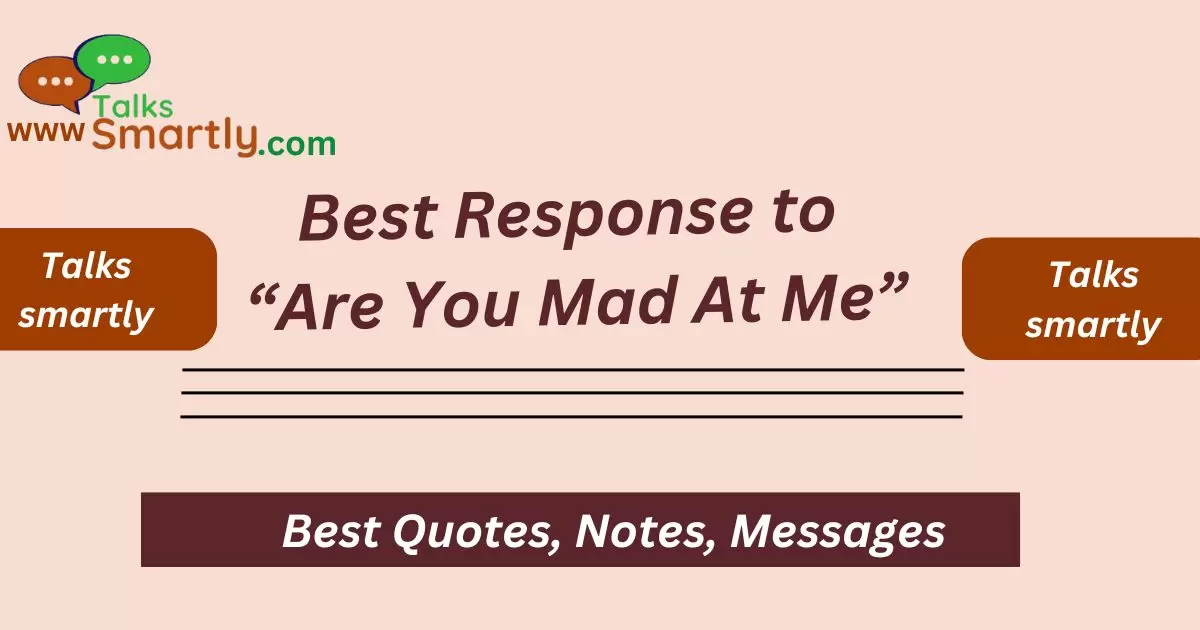Introduction
“Respond honestly and assure them you’re not mad, just busy. Offer to catch up later to ease any concerns.”
Navigating interpersonal communication can sometimes be tricky, especially when it comes to addressing potential conflicts or misunderstandings. One common scenario many of us encounter is being asked, Whether it’s from a friend, family member, or romantic partner, this question can stir up a range of emotions and requires a thoughtful response.
In this comprehensive guide, we’ll explore over 100 best responses categorized into different contexts and tones to help you navigate this delicate situation with grace and clarity.
Overview
This comprehensive guide provides over 100 best responses categorized into different contexts and tones for when someone asks, “Are you mad at me?” Whether you prefer a straightforward approach, a humorous response, or reassurance, the goal is to communicate honestly and respectfully to alleviate concerns and maintain healthy relationships.
Effective communication, sensitivity, and understanding are highlighted as essential elements in navigating such interpersonal scenarios with grace and empathy.
Best Response to Are You Mad At Me
- Honesty is the Best Policy: “No, I’m not mad. I just need some time to process things.”

- Assurance: “Not at all! I appreciate you checking in though.”
- Open Communication: “I’m not mad, but I’d love to talk about what’s on your mind.”
- Reassurance: “I’m not mad, just a bit preoccupied. Everything’s okay.”
- Clarity: “Nope, I’m not mad. Just having a quiet moment.”
- Understanding: “I’m not mad, just feeling a bit overwhelmed right now.”
- Affirmation: “I’m not mad, I promise. Just lost in thought.”
- Reassurance: “I’m not mad, just dealing with some stuff. Thanks for asking though.”
- Transparency: “Nope, not mad. Just need some time to myself.”
- Gratitude: “Thanks for checking in, but no, I’m not mad.”
- Understanding: “I’m not mad, just processing a few things.”
- Clarification: “I’m not mad, just deep in thought. Let’s catch up later.”
- Reassurance: “I’m not mad, just a bit tired. Don’t worry.”
- Openness: “No, I’m not mad. Just lost in my own world for a bit.”
- Acknowledgment: “I’m not mad, just need some space to clear my head.”
- Gratitude: “Thanks for checking, but I’m not mad. Just taking a breather.”
- Transparency: “Nope, not mad. Just need some time to recharge.”
- Reassurance: “I’m not mad, just wrapped up in my thoughts.”
- Assurance: “No, not mad. Just processing things at the moment.”
- Understanding: “I’m not mad, just feeling a bit introspective right now.”
- Openness: “Nope, not mad. Just lost in my own thoughts.”
- Reassurance: “I’m not mad, just need a moment to myself.”
- Affirmation: “I’m not mad, just pondering a few things.”
- Acknowledgment: “No, not mad. Just need some quiet time.”
- Transparency: “I’m not mad, just sorting through some thoughts.”
- Gratitude: “Thanks for checking, but I’m not mad. Just processing.”
- Reassurance: “I’m not mad, just reflecting on a few things.”
- Clarity: “Nope, not mad. Just lost in thought.”
- Understanding: “I’m not mad, just need some time to myself.”
- Transparency: “Not mad, just a bit lost in my own world.”
Funny Reply to Are You Mad At Me
- Humor: “Mad? Nah, just plotting world domination. Care to join?”
- Playfulness: “Mad? Only if you stole my last slice of pizza!”

- Lightness: “Mad? Nah, just mentally composing my next TikTok dance.”
- Sarcasm: “Mad? Of course not! I’m just rehearsing my Oscar acceptance speech.”
- Ridiculousness: “Mad? No way! I’m just contemplating the mysteries of the universe.”
- Quirkiness: “Mad? Nope, just practicing my interpretive dance moves.”
- Absurdity: “Mad? Never! I’m just perfecting my alien language skills.”
- Exaggeration: “Mad? Absolutely not! Just summoning my inner Zen master.”
- Whimsicality: “Mad? Nah, just pondering the meaning of life. The usual.”
- Silliness: “Mad? Only if you consider my love for cheese to be madness!”
- Irreverence: “Mad? Not a chance! Just trying to outwit my pet goldfish.”
- Wit: “Mad? Perish the thought! Just debating whether cats are plotting world domination.”
- Absurdity: “Mad? Nah, just polishing my invisible crown.”
- Lightheartedness: “Mad? Only if you count my love for bad puns!”
- Whimsy: “Mad? Never! Just composing a love letter to my favorite book.”
- Irony: “Mad? Not in a million years! Just trying to teach my toaster to sing opera.”
- Playfulness: “Mad? Nah, just trying to break my record for consecutive hours spent binge-watching Netflix.”
- Sarcasm: “Mad? Of course not! Just perfecting my impression of a penguin.”
- Exaggeration: “Mad? Absolutely not! Just trying to calculate the airspeed velocity of an unladen swallow.”
- Absurdity: “Mad? No way! Just planning my next adventure with the unicorns.”
- Whimsy: “Mad? Never! Just practicing my psychic abilities.”
- Silliness: “Mad? Only if you count my obsession with conspiracy theories!”
- Irreverence: “Mad? Not a chance! Just plotting a revolution with my rubber duck.”
- Wit: “Mad? Perish the thought! Just trying to decipher the language of squirrels.”
- Absurdity: “Mad? Nah, just consulting my crystal ball.”
- Lightheartedness: “Mad? Only if you consider my love for terrible puns to be madness!”
- Whimsy: “Mad? Never! Just debating whether to join a circus or start my own.”
- Irony: “Mad? Not in a million years! Just teaching my cat to do backflips.”
- Playfulness: “Mad? Nah, just trying to see if I can balance a spoon on my nose for an hour.”
- Sarcasm: “Mad? Of course not! Just planning my escape to the moon.”
Read More: Best Responses to “Hello”
How to respond to are you mad at me text
- Prompt Reply: Respond promptly to acknowledge receipt of the message.
Example: “Hey, just got your text. No, I’m not mad at all. Just caught up with some work. Let’s catch up later!”
- Clarity: Be clear and direct in your response to alleviate any concerns.
Example: “Thanks for checking, but no, I’m not mad. Just dealing with a lot at the moment. We’re good!”
- Assurance: Provide reassurance to the sender that everything is okay between you two.
Example: “Hey, no need to worry! I’m not mad. Just taking some time to myself. Let’s chat soon!”
- Openness: Encourage open communication by expressing your willingness to talk things through.
Example: “I’m not mad, but if something’s on your mind, feel free to share. We can discuss it together.”
- Understanding: Show understanding and empathy towards the sender’s concerns.
Example: “I get why you might think that, but no, I’m not mad. Just having a bit of a rough day. Thanks for checking though!”
- Affirmation: Reassure the sender that their friendship/relationship is important to you.
Example: “Hey, I’m not mad. Our friendship means a lot to me. Let’s not let any misunderstandings come between us.”
- Transparency: Be transparent about your feelings and current state of mind.
Example: “Nope, not mad. Just need some time to process things. Thanks for asking though!”
- Gratitude: Express gratitude for the sender’s concern while clarifying your emotional state.
Example: “Thanks for checking in, but no, I’m not mad. Just need a bit of space. Talk soon!”
- Reassurance: Offer reassurance that any perceived tension is not directed towards them.
Example: “I’m not mad at you at all. Just dealing with some personal stuff. Let’s catch up when things settle down!”
- Empathy: Show empathy towards the sender’s feelings and reassure them of your own.
Example: “I understand why you might think that, but I’m not mad. Just need some time to myself. We’re good!”
- Respect: Respectfully address the sender’s concerns while clarifying your emotions.
Example: “No, I’m not mad. Just need some time to process things. Thanks for checking in though!”
- Acknowledgment: Acknowledge the sender’s message and reassure them of your emotional state.
Example: “Hey, just saw your text. No, I’m not mad. Just a bit overwhelmed with work. We’re all good!”
- Clarity: Clarify any misunderstandings and assure the sender of your positive feelings towards them.
Example: “I’m not mad, just dealing with some personal stuff. Thanks for checking though. Let’s catch up soon!”
- Positivity: Keep the tone positive and light-hearted to ease any tension.
Example: “Nah, not mad! Just trying to survive this crazy week. Let’s grab coffee and catch up!”
- Reassurance: Reassure the sender of your affection and positive intentions.
Example: “Nope, not mad. Just need a bit of time to myself. Thanks for checking in though!”
- Understanding: Show understanding towards the sender’s concerns and reassure them of your feelings.
Example: “I understand why you might think that, but no, I’m not mad. Just a bit stressed. Let’s talk soon!”
- Openness: Keep the lines of communication open by expressing your willingness to discuss any issues.
Example: “I’m not mad, but if something’s bothering you, feel free to share. We can work through it together.”

- Assurance: Assure the sender that any perceived tension is not directed towards them.
Example: “Not mad at you, just dealing with some personal stuff. We’re all good. Thanks for asking though!”
- Empathy: Show empathy towards the sender’s concerns and reassure them of your positive feelings.
Example: “I’m not mad, just caught up with some things. Thanks for checking though. Let’s catch up soon!”
- Reassurance: Reassure the sender of your friendship/relationship and clarify any misunderstandings.
Example: “Nope, not mad. Just need some time to recharge. We’re good, don’t worry!”
- Transparency: Be transparent about your emotions while reassuring the sender of your positive feelings.
Example: “I’m not mad, just need some time to process things. Thanks for checking in though!”
- Gratitude: Express gratitude for the sender’s concern while clarifying your emotional state.
Example: “Thanks for checking in, but no, I’m not mad. Just need a bit of space. Talk soon!”
- Reassurance: Offer reassurance that any perceived tension is not directed towards them.
Example: “I’m not mad at you at all. Just dealing with some personal stuff. Let’s catch up when things settle down!”
- Empathy: Show empathy towards the sender’s feelings and reassure them of your own.
Example: “I understand why you might think that, but I’m not mad. Just need some time to myself. We’re good!”
- Respect: Respectfully address the sender’s concerns while clarifying your emotions.
Example: “No, I’m not mad. Just need some time to process things. Thanks for checking in though!”
- Acknowledgment: Acknowledge the sender’s message and reassure them of your emotional state.
Example: “Hey, just saw your text. No, I’m not mad. Just a bit overwhelmed with work. We’re all good!”
- Clarity: Clarify any misunderstandings and assure the sender of your positive feelings towards them.
Example: “I’m not mad, just dealing with some personal stuff. Thanks for checking though. Let’s catch up soon!”
- Positivity: Keep the tone positive and light-hearted to ease any tension.
Example: “Nah, not mad! Just trying to survive this crazy week. Let’s grab coffee and catch up!”
- Reassurance: Reassure the sender of your affection and positive intentions.
Example: “Nope, not mad. Just need a bit of time to myself. Thanks for checking in though!”
- Understanding: Show understanding towards the sender’s concerns and reassure them of your feelings.
Example: “I understand why you might think that, but no, I’m not mad. Just a bit stressed. Let’s talk soon!”
Best response to are you mad at me from a guy
- Directness: “Nope, not mad. Just focused on finishing this project. Let’s hang out later!”
- Assurance: “Hey, I’m not mad. Just caught up with work. How about we grab dinner tonight?”
- Honesty: “Not mad at all. Just need some downtime. Let’s plan something fun for the weekend!”
- Reassurance: “No, I’m not mad. Just sorting through some stuff. Let’s talk over coffee?”
- Clarity: “I’m not mad, just swamped with deadlines. Let’s catch up soon though!”
- Openness: “Not mad, just need some alone time. Let’s chill tomorrow?”
- Understanding: “I’m not mad, just dealing with some family stuff. Let’s grab a drink later?”
- Transparency: “Nope, not mad. Just need some space. Let’s hang out this weekend?”
- Gratitude: “Thanks for checking, but no, I’m not mad. Just need a bit of time. Let’s catch up soon!”
- Reassurance: “No, I’m not mad. Just wrapped up in my thoughts. Let’s hang out tomorrow?”
- Acknowledgment: “I’m not mad, just need some quiet time. Let’s catch up over lunch?”
- Clarity: “Not mad, just caught up with work. Let’s plan something for the weekend?”
- Positivity: “Not mad, just a bit stressed. Let’s go for a run later to unwind?”
- Reassurance: “Nope, not mad. Just need some time to recharge. Let’s hang out soon!”
- Understanding: “I understand why you might think that, but I’m not mad. Just need a bit of space. Let’s talk soon!”
- Openness: “I’m not mad, but if something’s bothering you, feel free to share. We can work through it together.”
- Assurance: “Not mad at you, just dealing with some personal stuff. We’re all good. Thanks for asking though!”
- Empathy: “I’m not mad, just caught up with some things. Thanks for checking though. Let’s catch up soon!”
- Reassurance: “Nope, not mad. Just need a bit of time to myself. Thanks for checking in though!”
- Understanding: “I understand why you might think that, but no, I’m not mad. Just a bit stressed. Let’s talk soon!”
Conclusion
In conclusion, responding to the question “Are you mad at me?” requires sensitivity, clarity, and understanding. Whether you choose a straightforward approach, inject humor to lighten the mood, or opt for reassurance to ease any concerns, the key is to communicate honestly and respectfully.
By utilizing the diverse range of responses provided in this guide, you can navigate this common social scenario with confidence and empathy, fostering stronger relationships in the process. Remember, effective communication is the cornerstone of healthy interactions, so choose your words wisely and approach each exchange with empathy and understanding.












